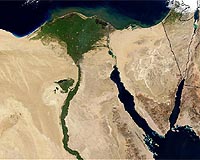 |
Darkan, Mongolia (SPX) May 16, 2011 Mongolia is a country of contrasts - in summer boiling hot, in winter freezing cold; in the north damp, in the south bone dry. One million of its three million inhabitants live tightly packed together in the capital Ulaanbaatar, while the rest of the huge country is largely populated by nomads and their cattle. Providing a clean supply of drinking water across the entire country is a difficult challenge - beginning with the need to lay freeze-proof water pipes over an area of 1.5 million square kilometers. The people in the countryside therefore use water from rivers, or from wells that they dig themselves. But these traditional ways of obtaining water are reaching the limits of their capacity. In recent decades the periods of rain during the summer months which replenish the reserves of groundwater have become infrequent. They have been replaced by heavy storms unleashing torrents of rain that runs off rapidly without soaking into the ground. At the same time, demand for water has risen with the rapid growth in the country's population. "Providing a supply of drinking water is becoming more and more difficult. To create a reliable supply in the long term you have to take many different factors into account and find out how they influence each other," explains Dr. Buren Scharaw from the Fraunhofer Application Center System Technology AST in Ilmenau. Born in Mongolia, he has been working for many years on the a project entitled "Integrated Water Resources Management for Central Asia: Model Region Mongolia", known also as MoMo. Project partners include the universities of Heidelberg and Kassel, Bauhaus University Weimar, the Helmholtz Center for Environmental Research, the Leibniz Institute for Freshwater Ecology and Inland Fisheries and various private-sector enterprises. The model region under study by the research scientists is the catchment area for the Kharaa River and Darkhan, a city of 100,000 inhabitants. Since the start of the project, in 2006, Scharaw has traveled back to his homeland several times. He has examined the quality of the water from public and private wells along with the distribution network, measured the energy consumption of pumps, and investigated the effectiveness of the sewage system. All of the data he has meanwhile collected has been fed into the computer models developed at Fraunhofer AST. "Our HydroDyn water management solution makes it possible for the first time to visualize the quality as well as the quantity of water resources and to model their future development," the scientist explains. There is plenty of scope for improvement: the water pumps consume lots of energy, the water pipes are in need of repair and nearly half of the drinking water is lost on its way to the consumer because of leaks. Many yurts have their own wells, but the water is often contaminated with bacteria from latrines. What can be done? "Having collected data and produced models we are now preparing proposals that make sense in economical and ecological terms", says Scharaw. His team has developed a software program for the purpose which can determine how the water supply can be sustainably secured using less energy. To minimize the losses in the drinking water distribution network, the Fraunhofer research scientists have also developed a measuring system for locating leaks. Small sensors detect any drop in pressure in the pipes, enabling leakes to be localized with relatively high precision. Once the leak has been found, that section of the pipe can be repaired. To reduce contamination in the water supply, and to increase the efficiency of the sewage system, the MoMo scientists are now building a test sewage plant which contains microorganisms in high concentration: "We expect this test facility to deliver good results also during the cold season when the microorganisms are less active. The findings can then be transferred to a future full-scale plant." In three years' time, when the MoMo project has been completed, the experts intend to present the government administration in Darkhan with a catalogue of measures which will show how the water supply and sewage system can be efficiently and cost-effectively secured. Scharaw regards it as one of his major successes that he prompted the Mongolian authorities to discontinue mining operations in some regions of the Kharaa catchment area - an achievement that extends far beyond improving the drinking water supply in Darkhan.
Share This Article With Planet Earth
Related Links Fraunhofer-Gesellschaft Water News - Science, Technology and Politics
 Egyptian PM in Ethiopia for Nile talks
Egyptian PM in Ethiopia for Nile talksAddis Ababa (AFP) May 13, 2011 Egyptian Prime Minister Essam Sharaf was in Ethiopia for an official visit Friday, devoted mainly to talks on sharing the waters of the Nile, an issue at the centre of high tensions between the two countries. Sharaf, who arrived in Addis Ababa on Thursday, had a meeting behind closed doors for several hours with his Ethiopian counterpart, Meles Zenawi, an AFP journalist witnessed. "Ethio ... read more |
|
| The content herein, unless otherwise known to be public domain, are Copyright 1995-2010 - SpaceDaily. AFP and UPI Wire Stories are copyright Agence France-Presse and United Press International. ESA Portal Reports are copyright European Space Agency. All NASA sourced material is public domain. Additional copyrights may apply in whole or part to other bona fide parties. Advertising does not imply endorsement,agreement or approval of any opinions, statements or information provided by SpaceDaily on any Web page published or hosted by SpaceDaily. Privacy Statement |